| Srl | Item |
| 1 |
ID:
108532
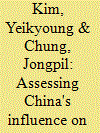

|
|
|
|
|
| Publication |
2011.
|
| Summary/Abstract |
It is widely known that China's influence on Southeast Asia has been growing
rapidly since the Asian financial crisis of 1997. However, determining the true
dimensions of China's influence in this region is still controversial. It seems quite
conspicuous that the growing economic relations between China and the region
give China more bargaining power, due to the expanding role of the bilateral trade
and China's foreign aid in promoting the regional economic growth. However,
this does not give us a clear picture of how China has been able to exercise its
influence on the behavior of the states in the region for its own interests. Therefore,
this paper tries to assess China's influence on Southeast Asia by analyzing the
specific case of Taiwan. Recently, China's rising influence has significantly
affected Southeast Asia's relations with Taiwan. Southeast Asian states are paying
more attention to the cross-Strait relations when considering attempting to improve
relations with Taiwan. This research defines "influence" as the capability of state
A to affect the behavior of state B, either directly or indirectly, to comply with state
A's policy interests. If the diplomatic behavior of state B changes accordingly
due to the action, then it can be said that state A has illustrated its influence over
state B. By studying the Taiwan issue, this paper reveals that China has been
quite successful in exercising its influence on Southeast Asian states to comply
with China's policy toward Taiwan.
|
|
|
|
|
|
|
|
|
|
|
|
|
|
|
|
| 2 |
ID:
178910
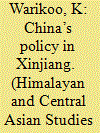

|
|
|
| 3 |
ID:
106560
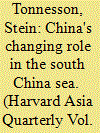

|
|
|
| 4 |
ID:
156062
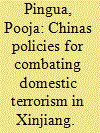

|
|
|
|
|
| Summary/Abstract |
Today, ethnic separatism, religious extremism and terrorism pose a serious challenge to the integrity and unity of China. By upgrading and enhancing the economic status of the Uyghur, Beijing hopes to undermine their demand for an independent homeland. Pooja Pingua analyses China’s policies for combating domestic terrorism in Xinjiang.
|
|
|
|
|
|
|
|
|
|
|
|
|
|
|
|
| 5 |
ID:
192379
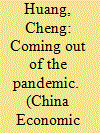

|
|
|
|
|
| Summary/Abstract |
In this editorial, we reviewed the articles collected in the special issue “Economics of Pandemic Disease” along with other relevant literature. We found that the pandemic has had a devastating impact on the economy as a whole and on small and medium-sized enterprises (SMEs) and private firms in particular, which may have deepened the economic inequality and impeded poverty reduction in China. The pandemic also resulted in substantial damage to the mental health and well-being of the Chinese population, with a disproportionate impact on minorities, including the female and the illiterate. We also examined the available evidence regarding the effectiveness of China's policy response to the COVID pandemic, which suggested that China's zero-Covid policy succeeded in stabilizing its economy and maintaining a safe environment in earlier phases of the pandemic, but hardly achieved a balance between disease control and economic growth in the later stage when less fatal but more transmissive coronavirus variants emerged. Lastly, we discussed policy options that China may take to protect the health of its people and avoid a potentially substantial loss of lives during the transition toward the post-pandemic new normal, which include prioritizing the timely administration of effective vaccines among the elderly and vulnerable populations, improving public communications regarding when and how to seek medical help, and strengthening the surge capacity of the healthcare systems, especially in less developed regions.
|
|
|
|
|
|
|
|
|
|
|
|
|
|
|
|